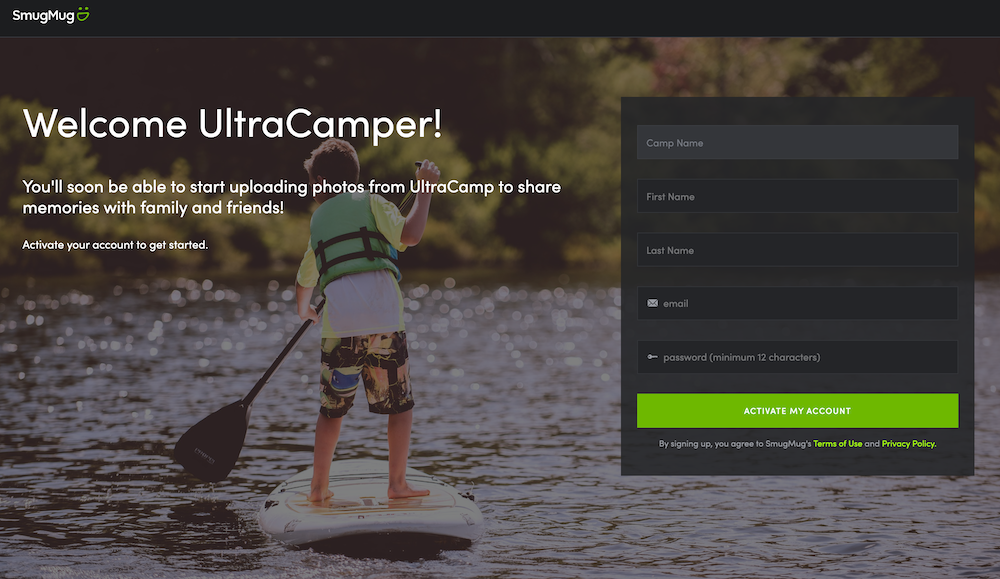
Decode Camp Staff Burnout: The Camp Staff Experience Wheel
The Camp Experience Wheel: Measuring the Camp Staff Experience Imagine this: it’s mid-July, the sun is blazing, and your camp is in full swing. Campers […]
Get in touch with any product inquiries you may have and we’ll do our absolute best to answer your questions by the next business day.
Want to see how UltraCamp could be utilized for your exact needs and situation? The first step is to schedule a quick 15-minute call so we can understand your unique needs. Next, we'll create a demo tailored to your camp. It will look and feel like you’ve opened registration already.
Managing the daily chaos of camp administration is no easy task. You’re managing registrations, deciphering the cryptic texts from teen counselors, catering to the changing preferences of young campers, and of course, there is the annual budget meeting to make your case for a more realistic budget. What you need is a dependable assistant who can help tame the madness without leaving the very next summer to chase after that “life-changing” internship.
This is what Generative AI promises and why everyone seems to be talking about ChatGPT, Claude or the various other Generative AI Models. For just $0 to $20 per month, these Generative AI’s deliver 24/7 support customized to the unique craziness of your camp. At least that is what all the hype seems to suggest.
Generative AI may not be the end to all problems, but it can certainly elevate your capabilities in a lot of ways. Plus, ChatGPT never sleeps, never slacks, and did we mention it works for cheap? In the sections below, we’ll explore some key strategies and examples for prompting ChatGPT (or any Generative AI) in a way that provides the most helpful and tailored outputs for common camp management tasks. From setting the context to requesting specific structures, you’ll gain actionable tips for getting the AI to work for you.
There was a time when I found myself at a social gathering where I didn’t know a soul, so I was doing my usual routine of awkwardly hanging out in a corner. Suddenly, I overheard two guys nearby chatting about cars and I thought, “Perfect! This is my chance to flaunt my car knowledge and to stop standing here awkwardly.” As it turned out, I was completely off the mark on both counts. The men were professional mechanics, and my awkwardness instantly skyrocketed.
To flourish, whether in life or at work, we need to comprehend as much of the situational context as possible. This could mean understanding the ages, physical abilities, or fears of our campers. The same principle applies when interacting with ChatGPT. Like us, it learns and adapts, but only within the boundaries of a specific chat session. Every time you initiate a new chat session, its entire understanding of you – your camp, your role, your communication style, and so on – all starts from scratch.
My advice is to write down a brief note that encapsulates the essential context about your camp and any preferred writing styles. This way, you can quickly copy and paste it whenever you need to provide ChatGPT with more background. The more ChatGPT understands your specific situation, goal, and constraints, the better it can assist you in whatever task you are seeking help with. Below is an example you can copy and modify for your specific use case.
Pine Tree Camp Details:
- Session Name: Adventure Camp
- Location: Adirondacks
- Camper Age Range: 7-16
- Number of Campers: 200 per session
- Number of Cabins: 20
- Activities: Swimming, archery, hiking, arts & crafts, etc.
- Staff Roles: Counselors live with campers and are responsible for supervision.
**Directive:**
Write a description of the camp Session:
Perspective holds great power as it enables us to broaden our thinking and explore new possibilities. In my experience, ChatGPT has proven to be incredibly useful in offering perspectives that I may have overlooked. By simply prompting it to adopt a specific viewpoint, like “Imagine being the parent of a 10-year-old attending camp for the first time; what questions might you have?”, ChatGPT can provide valuable insights. You can then use these insights as a basis for creating social media content, FAQs, and more. The aim of this type of prompting is to utilize a different perspective to gain fresh insights for any project you are working on.
However, that is not the only use case for assigning a persona or role to GPT. By prompting a Generative AI to take on a different role such as a web developer, an activity coordinator, or even a social media influencer, you are essentially equipping it with the mindset it needs to adopt for the specific task at hand. This results in its greater understanding of how to more accurately predict the types of results you want from it.
Example Prompt:
You are a camp activity specialist for a wilderness adventure camp. The camp already offers activities like rock climbing, kayaking, and wilderness survival training. I'm interested in creatively enhancing these existing activities to make them more fun and educational for next summer, without incurring significant additional costs.
Please suggest three innovative twists on our current activities. Include how to implement them with our existing equipment, any additional safety measures needed, and the educational value they would add.
Let’s be real: trying to plan everything for a summer camp can quickly turn into a mess of tangled to-do lists. Before you know it, you’re staring down a mountain of half-formed ideas without any clear sense of how to actually make them happen. This is where ChatGPT can be a total game changer for camp directors and counselors. Simply describe the activity or event you want to run, and prompt ChatGPT to generate an easy-to-follow action plan.
For example, say you want to organize an epic outdoor scavenger hunt for the campers. Ask ChatGPT to “provide a detailed list of steps and materials needed to create a fun scavenger hunt for kids.” It’ll outline everything from making clue cards to hiding items around your location.
The beauty of ChatGPT is that you can easily adapt your prompts to fit any situation. Whether you need to modify the scavenger hunt for younger campers, accommodate campers with disabilities, or move it indoors due to weather, ChatGPT makes it simple to tailor the plan to your specific needs and considerations. Within seconds, you’ll have an easy-to-edit first draft that meets your requirements.
Leveraging ChatGPT takes the grunt work out of camp planning. You’ll get clear, actionable steps generated in seconds – leaving you more time for hanging with campers!
Example Prompt:
We're planning a big campfire night at our summer camp, and we want it to be a memorable experience for the campers. The event will have storytelling, marshmallow roasting, and a small fireworks display. Can you provide a step-by-step guide on how to organize and execute this campfire night to ensure it is both safe and enjoyable for everyone? Include logistical considerations, safety precautions, and how to engage the campers in the activities.
Imagine you’re at a restaurant with endless options on the menu. Would you simply tell the server, “Make me something good,” and leave it at that? Probably not. You’d likely specify your preferences, such as how you want your steak cooked or which sides you’d like. When interacting with ChatGPT for camp management, this level of specificity is equally important. Your prompts are your custom order to the AI. Whether you’re keen on generating a detailed event plan or crafting social media posts that resonate with your audience, clarity in your requests gives you more control over the outcomes.
Clearly State Desired Structure: To get the most specific and helpful output, consider detailing a structure or template that it must follow within your prompt. This ensures that you not only get all the information you need but also receive it in a format that’s ready for immediate use with minimal editing.
Example prompt:
You are the Camp Nutritionist. We have 100 campers that arive monday afternoon and leave friday morning before lunch. The Campers are ages 8-12.
Based on the provided information about the number of campers and their age group, generate a detailed meal plan for a week at a summer camp. Your plan should include:
The meal plan should prioritize nutritional balance, accommodate common food allergies, and be practical to prepare in a camp setting. Use the number of campers, their ages, and any dietary restrictions to estimate appropriate food quantities. Present the plan in a table format that separates meals by day and type (breakfast, lunch, dinner, snacks). Also, produce a comprehensive shopping list, detailing specific brands, sizes, and quantities of the ingredients needed. Make sure to make the plan budget friendly.
Clearly Indicate Length and Format: If you have preferences about the length or format of the output—be it bullet points, numbered lists, short paragraphs, or even character count—state these explicitly. This ensures that you get information in a way that suits your needs, without the need for extensive editing.
Example prompt:
We're running a wilderness adventure camp for kids aged 12-16. Today, the campers participated in kayaking, nature photography, and a campfire cook-off. Write 3 different 2-3 sentence posts for our camp's Instagram account that highlights these activities and captures the adventurous spirit of our camp. End the post with an inspiring hashtag.
When faced with complex issues, especially those involving children and their parents, clear communication is key. ChatGPT, as a predictive algorithm, excels in these situations by thoroughly analyzing the nuances of each interaction to provide accurate and helpful strategies for resolution. Think of ChatGPT as a tool that categorizes questions and concerns, breaking down complex challenges into manageable pieces, similar to solving a puzzle. The first step in solving any challenging puzzle is to sort the pieces, making the task of assembling the puzzle much more straightforward. In the same way, ChatGPT takes the complexities of a situation, breaks them down, and then strategically offers clear and concise solutions, acting as a valuable asset in unraveling the complexities that can often arise in communication.
Example prompt:
A concerned parent sent the following confusing message:
"Hi there, I was going through the camp brochure and couldn't help but get more confused about a few things. My son David is gluten-free, but also really hates fruits. And then you mention a lake, but David is still a beginner swimmer. I'm concerned? His EpiPen for bee stings also needs to be nearby. Is it with him, or does someone else hold on to it? David tends to keep to himself, what kind of activities can lure him out of his shell? Oh, and he's addicted to his gaming console. Do you even allow such things there? I'm a bit on edge with all this, so I'd appreciate some details, if that's possible. Thanks!"
Break down the parent's message into distinct categories of concerns and questions. Then, outline the specific points that need to be addressed under each category in my reply to the parent.
Imagine you’re at a crossroads: should you upgrade the camp facilities or invest more into marketing? Decisions aren’t always as straightforward as we’d like them to be. Sometimes, they demand careful consideration of pros and cons, immediate needs, and long-term benefits. Engaging with ChatGPT can offer a deeper dive into your decision-making process. When posed with a situation, the model can engage in a structured debate, shedding light on each aspect of the scenario, bit by bit. So, the next time you find yourself stuck between two choices, remember to give ChatGPT a try. It’s not about replacing your judgment, but enhancing it, ensuring each decision is backed by well-rounded considerations of all the different pros and cons that you may not have thought of yourself.
Example prompt:
Our camp has received a modest budget increase for next year. We're trying to decide between investing in upgrading the camp facilities or enhancing our marketing efforts to attract more campers. Debate the following:
1) Discuss the potential benefits and drawbacks of upgrading the camp facilities.
2) Discuss the potential benefits and drawbacks of enhancing our marketing efforts.
3) Consider which option is more urgent, given the current state of the camp and its occupancy rates.
4) Weigh these factors to decide where the budget increase would be most effectively used.
Provide a final assesment from the debate.
ChatGPT holds exciting potential as a camp management aid, but realizing that potential requires us to communicate effectively with this AI tool. By using prompt strategies like establishing context, assigning roles, simplifying complexity and requesting specific formats, we can guide ChatGPT to deliver outputs that are custom-fit to our unique needs. While initially requiring some trial and error, prompting is a skill that improves with practice. While there may be a learning curve involved in the beginning, with practice, prompting becomes a skill that improves over time. Once mastered, you may discover that it frees up your time to focus on the aspects of camp that you truly enjoy.


The Camp Experience Wheel: Measuring the Camp Staff Experience Imagine this: it’s mid-July, the sun is blazing, and your camp is in full swing. Campers […]

Here are some fun activities and icebreakers perfect for the first day of camp! Mix these games in while going over the camp rules, and […]

UltraCamp has partnered with SmugMug, the leading photo sharing service, to bring you a fantastic new photo gallery integration. This new feature will make managing and […]

Subscribe to our newsletter for helpful camp tips & tricks
UltraCamp customer support is limited to camp administrators only. If you are not an administrator, please contact your camp or organization directly for assistance.